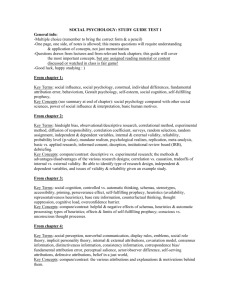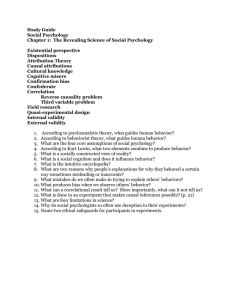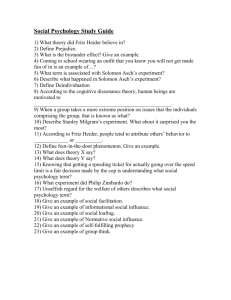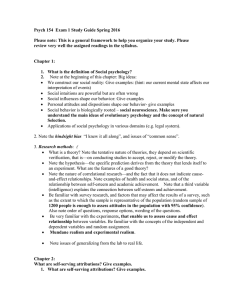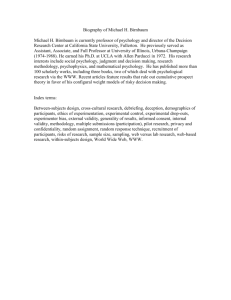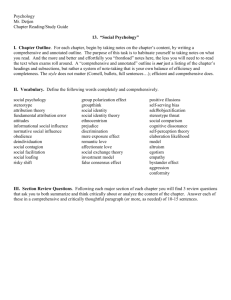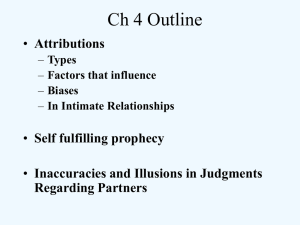Study Guide Test 1 - Gordon State College
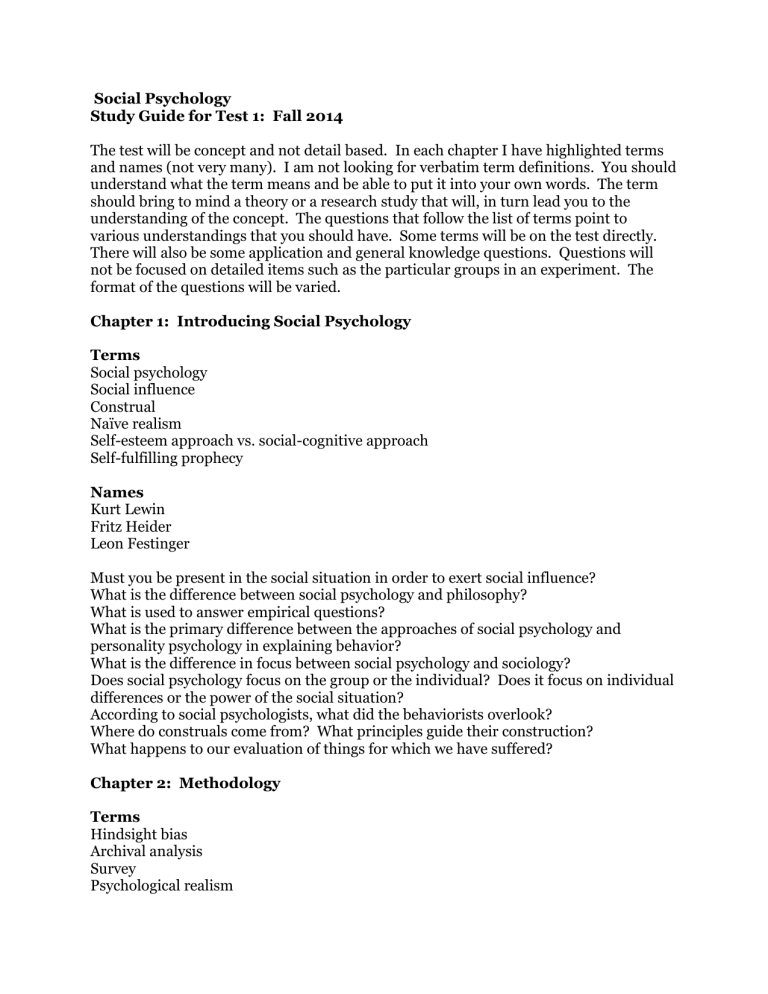
Social Psychology
Study Guide for Test 1: Fall 2014
The test will be concept and not detail based. In each chapter I have highlighted terms and names (not very many). I am not looking for verbatim term definitions. You should understand what the term means and be able to put it into your own words. The term should bring to mind a theory or a research study that will, in turn lead you to the understanding of the concept. The questions that follow the list of terms point to various understandings that you should have. Some terms will be on the test directly.
There will also be some application and general knowledge questions. Questions will not be focused on detailed items such as the particular groups in an experiment. The format of the questions will be varied.
Chapter 1: Introducing Social Psychology
Terms
Social psychology
Social influence
Construal
Naïve realism
Self-esteem approach vs. social-cognitive approach
Self-fulfilling prophecy
Names
Kurt Lewin
Fritz Heider
Leon Festinger
Must you be present in the social situation in order to exert social influence?
What is the difference between social psychology and philosophy?
What is used to answer empirical questions?
What is the primary difference between the approaches of social psychology and personality psychology in explaining behavior?
What is the difference in focus between social psychology and sociology?
Does social psychology focus on the group or the individual? Does it focus on individual differences or the power of the social situation?
According to social psychologists, what did the behaviorists overlook?
Where do construals come from? What principles guide their construction?
What happens to our evaluation of things for which we have suffered?
Chapter 2: Methodology
Terms
Hindsight bias
Archival analysis
Survey
Psychological realism
Cover story
Field experiment
Independent variable
Dependent variable
Replication
Meta-analysis
Internal experimental validity
External experimental validity
What are the three research methods? What is the focus of each and what are some of the limitations of each?
We did the exercise on page 23 of your textbook in class. Could you still make correct predictions?
Why do we use random sampling for surveys? Why do we use random assignment of participants to groups in experiments?
What will correlations not tell you? What will they tell you?
What is the only research method acceptable for finding evidence of causal relationships?
What does the p-value of reported experimental results indicate?
How do we accomplish the internal validity of experiments?
What are the different goals of basic and applied research?
According to APA Ethical Principles, under what conditions may deception be used in an experiment?
There are eight areas on page 41 of your textbook. You should be able to recognize all of them and to remember and describe three of them.
Chapter 3: Social Cognition
Terms
Automatic thinking
Schemas
Controlled thinking
Counterfactual thinking/reasoning
Base rate information
Priming
Priming metaphors
Judgmental heuristics
How do we use schemas?
How do we choose what schemas to use?
What makes a schema accessible?
Apply the use of the availability heuristic to medical diagnosis.
How do we use the representativeness heuristic? Does this always lead us to the right answer? Does it always lead us to the wrong answer? Do we tend to use it more than base rate information?
Does culture have more influence on controlled or automatic thinking? Why?
Describe the difference between analytic and holistic controlled thinking.
Is free will more closely associated with automatic or controlled thinking?
Give an example of when we feel we are exerting control, but we are not.
Are we more or less moral and/or helpful when we feel that we have a choice?
The easier it is to “undo” a past outcome, the stronger or the weaker the associated emotional reaction?
How do we “improve” human thinking to get people to be more objective?
Chapter 4: Social Perception
Terms
Non-verbal communication
Social perception
Implicit personality theory
Affect blends
Emblems
Display rules
Attribution theory
Internal vs. external attributions
Covariation model
Fundamental attribution error
Perceptual salience
Self-serving attributions
Defensive attributions
Bias blind spot
Just world hypothesis
Names
Fritz Heider
Harold Kelley
What are the six major emotional expressions?
Are they culturally universal?
What other personality characteristics are tied to warmth and to competence?
Do internal or external attributions tell you more about the person?
In happy marriages, do spouses tend to make internal or external attributions of their partner’s behavior?
What are the three variables used in the Covariation model? What patterns lead to internal or external attributions?
In the two-step process of attribution, what is considered first and what is considered second (or not at all)? Under what conditions are we most likely to consider the situation?
In what countries are the tendencies for self-serving attributions found to be the highest and the lowest?
Describe how holistic vs. analytic thinking can affect social perception.
